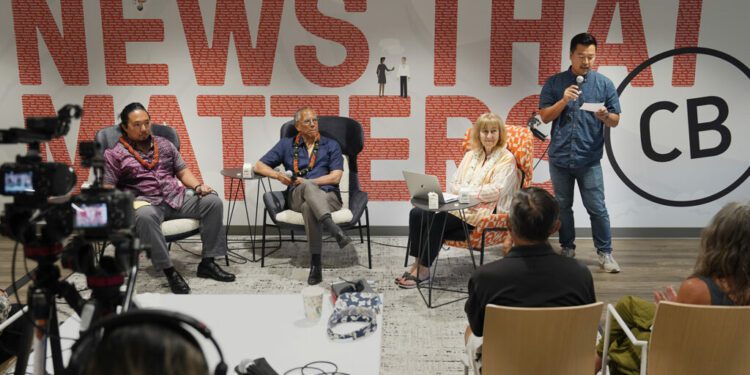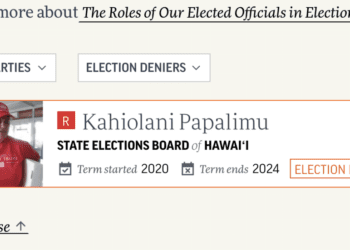When I was interviewing for the deputy editor job at Civil Beat 13 years ago, our founder and primary funder Pierre Omidyar asked me if I had any questions for him.
Yes, I said, I’ve been laid off twice in the last few years as the newspaper business collapses all over the place. I don’t want to move to Hawaii just to have to find another job in six months, so what’s the plan to to keep Civil Beat going?
Pierre’s answer was simple. I’ll keep it going as long as it’s making a difference.
Music to my ears for sure. I can do that, I said, when do I start?
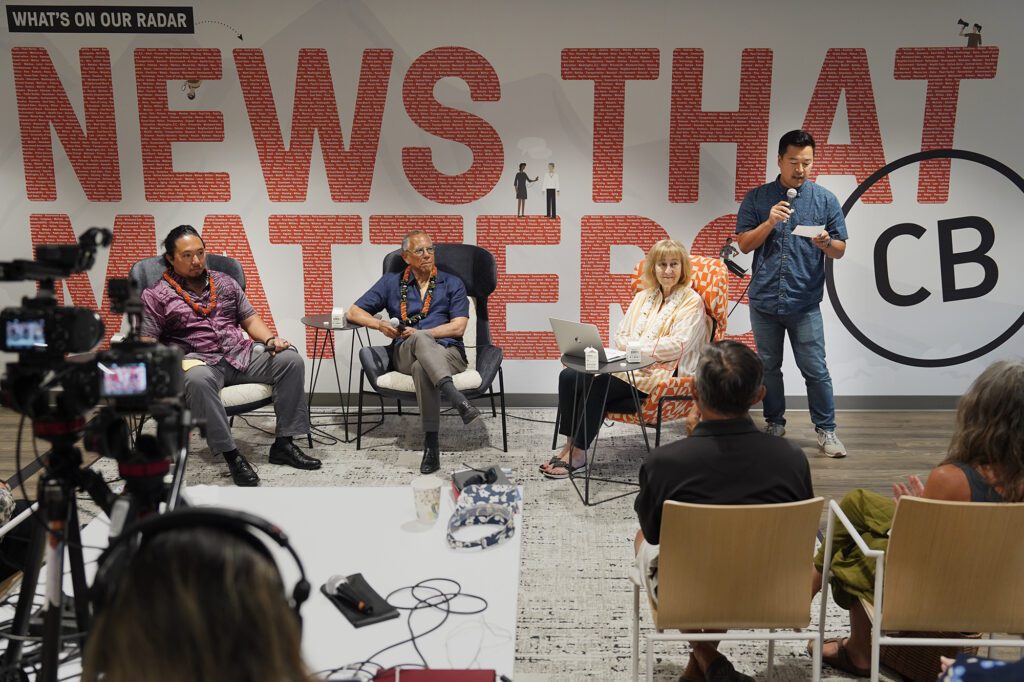
 Civil Beat Editor Patti Epler interviews Dean Baquet of The New York Times and Blaze Lovell, left, at a recent newsroom event. That’s Ben Nishimoto, our vice president for operations and philanthropy, introducing them. (Kevin Fujii/Civil Beat/2024)
Civil Beat Editor Patti Epler interviews Dean Baquet of The New York Times and Blaze Lovell, left, at a recent newsroom event. That’s Ben Nishimoto, our vice president for operations and philanthropy, introducing them. (Kevin Fujii/Civil Beat/2024)
Civil Beat launched under founding editor John Temple in 2010. I got here in 2011 and took over as Editor in 2012 when John left for the Washington Post.
I think that there’s no question we’ve certainly made a difference in Hawaii and even in national circles, more than living up to Pierre’s initial dream of launching a news organization that would help bring about positive social change in the islands while demonstrating a financially sound business model.
Now, I’m stepping aside — I’m not retiring, in fact, I’m not even leaving the paper — and handing the next decade of Civil Beat innovation and growth over to Amy Pyle. Amy, who starts as Civil Beat’s Executive Editor-In-Chief this week, was most recently the managing editor for investigations and storytelling at USA Today. Prior to that she was Editor-In-Chief at California’s Center for Investigative Reporting/Reveal and has been an investigative editor and reporter at The Sacramento Bee and The Los Angeles Times. Suffice it to say, she’s the real deal and well-known in journalism circles as a top editor and news visionary.
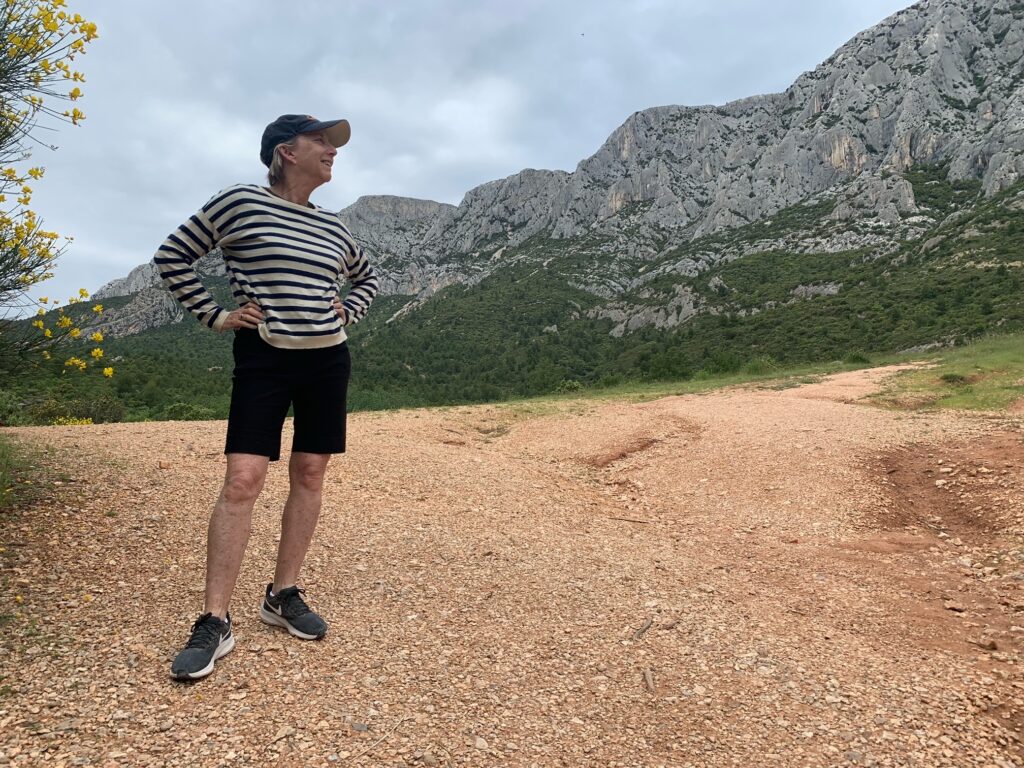
 Civl Beat’s new Executive Editor-In-Chief Amy Pyle is an avid hiker. She starts her new role at Civil Beat this week. (Robert Durrell photo)
Civl Beat’s new Executive Editor-In-Chief Amy Pyle is an avid hiker. She starts her new role at Civil Beat this week. (Robert Durrell photo)
I’ll let her tell you in a soon-to-come column where we’re going, but I’d like to talk a little bit about where we’ve been.
Longtime Civil Beat readers will remember that we started as a for-profit news site, selling subscriptions for $19.99 a month. By the time we decided to abandon that failed business model the cost of a subscription had fallen to $4.99 a month. There were just too many choices for people to get their news — from national outlets as well as local news sites — and Civil Beat allowed so many free reads per month that you really didn’t need to buy a subscription. Sales were pretty slow.
In 2016, we decided to join the growing number of nonprofit news sites springing up all over the country. At the time, a few dozen sites were starting to gain traction; now there are more than 450 members of the Institute for Nonprofit News.
And it turned out that people are much more inclined to support Civil Beat when we’re providing news for free in the public interest, especially the kind of investigative, watchdog and deep-dive explanatory reporting that no one else in Hawaii was doing. Our fundraising under the leadership of Ben Nishimoto, now Civil Beat’s vice president of operations and philanthropy, really took off and we have steadily increased revenue and reach year after year.
We now support a full-time staff of about 35 journalists and operations and engagement professionals and an annual budget of about $6 million that relies on Omidyar funding for less than half. And we’ve become a national model for other nonprofit news operations with members of our team serving in leadership positions in the industry or being sought after for advice.
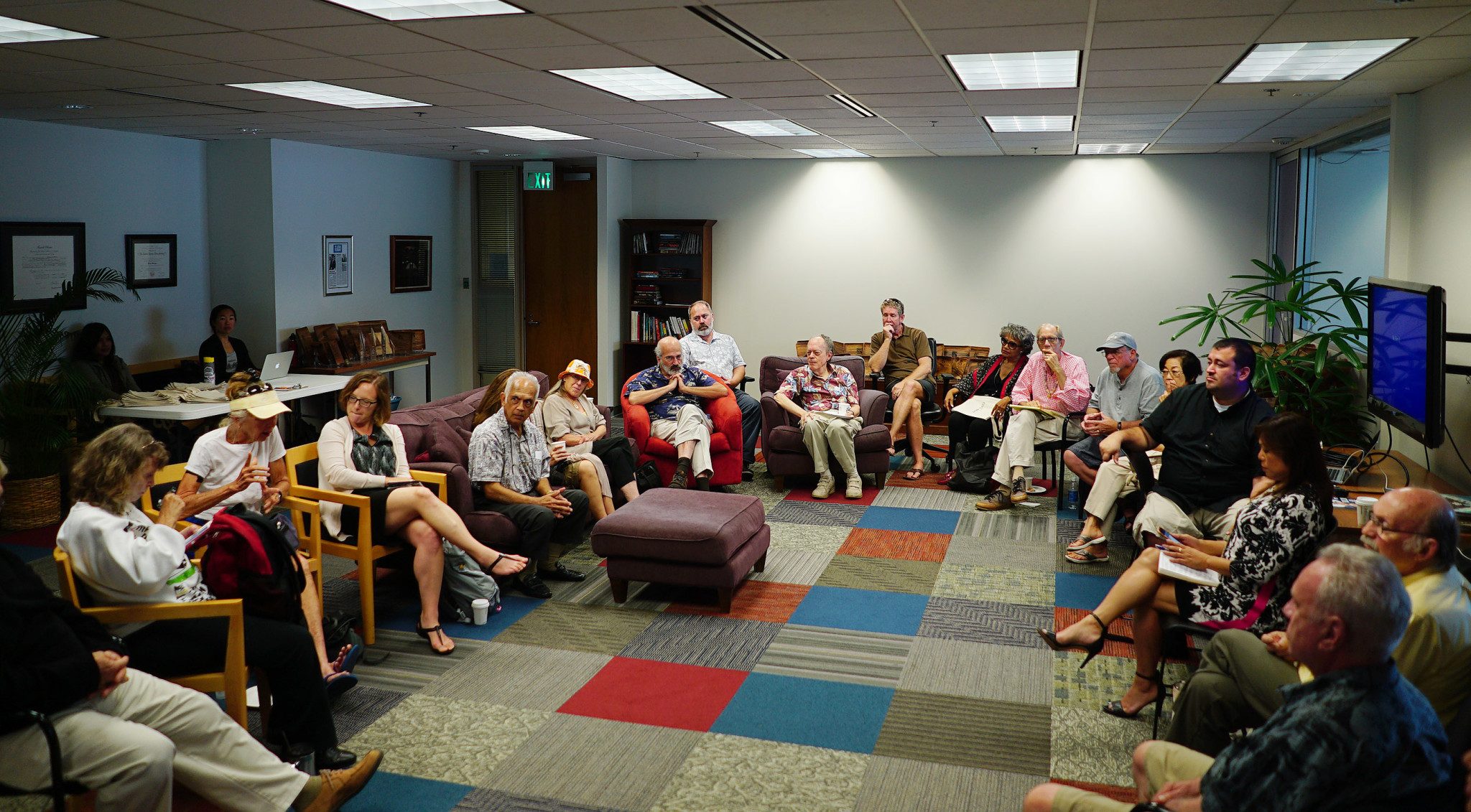
 A Civil Beat coffee discussion in our old office space soon after we became a nonprofit. We’ve been reaching out to the community as much as possible to bring readers inside the news operation. (Cory Lum/Civil Beat/2016)
A Civil Beat coffee discussion in our old office space soon after we became a nonprofit. We’ve been reaching out to the community as much as possible to bring readers inside the news operation. (Cory Lum/Civil Beat/2016)
And, in a sign that we’re going to be making a difference for a very long time, we have a brand new building with our name carved in stone on it in Kaimuki.
My view of what a great news organization should be has been shaped by decades of working for really excellent operations as well as some really bad ones. One of the great editors, the late Howard Weaver whom I worked for for many years at the Anchorage Daily News, used to describe the newspaper as the tribal fire at the heart of the community, the place where people could gather around to get the news of the day, to share stories with and about each other, to take comfort in hard times and celebrate the good times. To learn the good and the bad about their particular place on Earth and to together create a path forward toward better times.
It’s a vision I’ve kept squarely in sight all these years. So when Civil Beat became a nonprofit and began asking people to support our efforts it just made sense that Civil Beat needed to do more to support the community in return. Rather than just report and write stories that we’d publish on our website, we launched a robust engagement effort to bring discussion about the important issues facing Hawaii to people directly. Our events — like Civil Cafes and Hawaii Storytellers and pop-up newsrooms — have become so popular they sell out within days and we frequently have waiting lists.
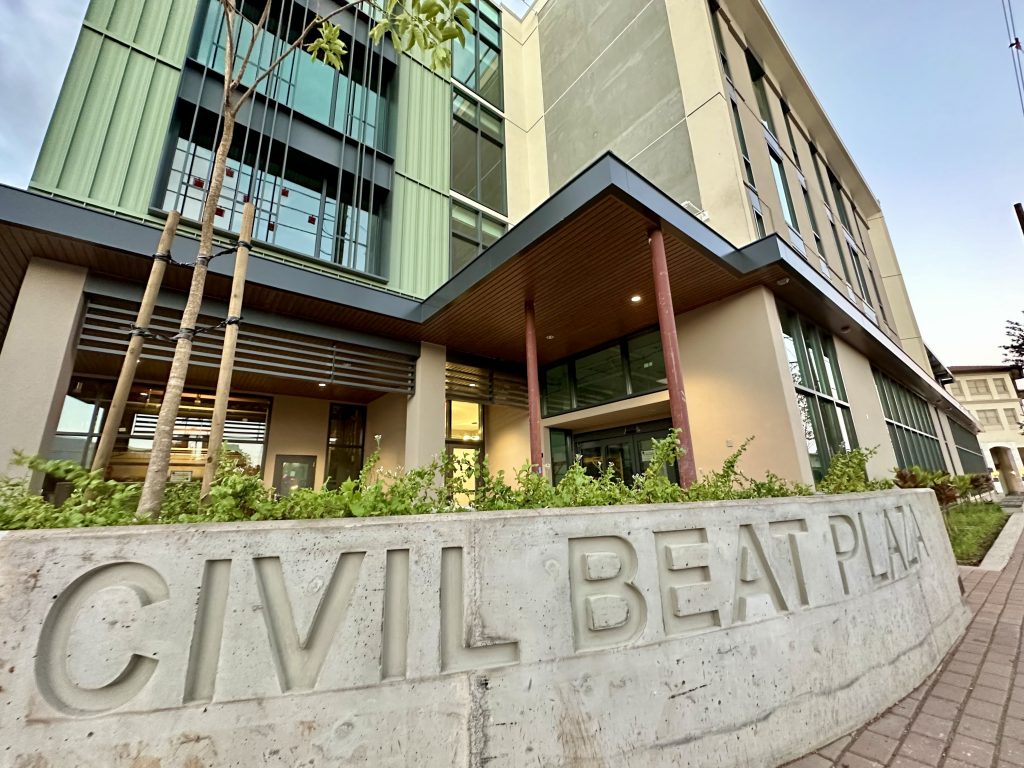
 We moved into a new office headquarters in Kaimuki in August 2023. (Nathan Eagle/Civil Beat/2023)
We moved into a new office headquarters in Kaimuki in August 2023. (Nathan Eagle/Civil Beat/2023)
One of the first things Civil Beat did under John Temple’s leadership was to publish the salaries of public employees. In 2010 that was a shock to the system in Hawaii even though it had long been standard journalistic fare throughout the country. We’ve kept that going year after year and added even more public information databases to our site, including creating and maintaining (no small feat) a searchable database of the financial disclosure reports filed by many public officials including judges.
We’ve produced Candidate Q&As as part of our election coverage every year since 2012. The surveys have become a highly popular resource for voters especially in the week or so leading up to the election as people scramble to fill out their ballots.
Over the years we’ve deeply examined certain issues that we felt no one was really talking about at the time we took them on — things like police misconduct and accountability, the cost of living, environment and climate change, even the lack of affordable housing and homelessness. Those signature issues are now routinely the subject of coverage by many in the media.

 Civil Beat has made it a point to find ways to engage the community to get people to pay attention to the events and issues in Hawaii. (Civil Beat graphic/2019)
Civil Beat has made it a point to find ways to engage the community to get people to pay attention to the events and issues in Hawaii. (Civil Beat graphic/2019)
We launched a joint venture with The Huffington Post in 2013 and for several years Hawaii got national attention as HuffPost Hawaii and its separate staff delivered news from this state as part of that then-giant media operation. In the last 10 years, we’ve regularly teamed up with other news organizations, some local and many national, to produce stories that are of common interest throughout the country.
That was the same year we helped create the Civil Beat Law Center for the Public Interest as a way to ferret out police misconduct records. Now called the Public First Law Center, Brian Black’s successful operation has always been independent from the news site but funded by the same Omidyar philanthropy. But he’s taken many of the cases generated by Civil Beat in the fight to strengthen public records and open meetings practices in Hawaii.
Two years ago we expanded to the neighbor islands and now have full-time reporters on Maui, Kauai and the Big Island. We’ve maintained our Washington, D.C., bureau since Adrienne LaFrance, now the executive editor of The Atlantic, pioneered that assignment in 2012.
There have been so many more rich and rewarding accomplishments along with some things that didn’t go so well over the past 13 years, it’s impossible to fit it all in this column. I should mention Civil Beat has been named the best online news site in Hawaii by the Society of Professional Journalists every year since we launched in 2010 and we’ve won a ton of national and regional awards. This year we were honored as a finalist for the Pulitzer Prize for our efforts in covering the Maui wildfires.


One of things I’m proudest of is our Sunshine Project, which we started in January 2023 to intensely focus on government and political accountability, transparency and ethics throughout all of our public institutions. “Let The Sunshine In” has served to shine a very bright light on the Legislature in particular and, sorry for burying the lede here as we like to say, but that’s where I’ll be focusing my attention once I smoothly hand off the running of Civil Beat to Amy in the coming months.
I’ll be the Ideas Editor, the section that is home to the Sunshine Project, and lead the Ideas staff in expanding our accountability coverage, including recruiting more sharp thinkers in the community to help us surface ideas around positive political reform. I’m looking forward to getting back to my roots in reporting and writing and producing more deeply reported analysis pieces that examine some of the ideas for change that are constantly being suggested but seem to get no traction with the current political leadership. We’ll be spreading the sunlight too, into the counties, the court system and other areas of government and business that remain a bit too murky.
It seems like a good way to make a difference in Hawaii. And that’s a promise I made 13 years ago.

Sign up for our FREE morning newsletter and face each day more informed.
Sign Up
Sorry. That’s an invalid e-mail.
Thanks! We’ll send you a confirmation e-mail shortly.
Source link : http://www.bing.com/news/apiclick.aspx?ref=FexRss&aid=&tid=66d6ee2474a84b8da26711a489b4a942&url=https%3A%2F%2Fwww.civilbeat.org%2F2024%2F09%2Fcivil-beat-this-leadership-change-brings-more-journalistic-firepower-to-hawaii%2F&c=15366732329281305592&mkt=en-us
Author :
Publish date : 2024-09-02 23:01:00
Copyright for syndicated content belongs to the linked Source.

